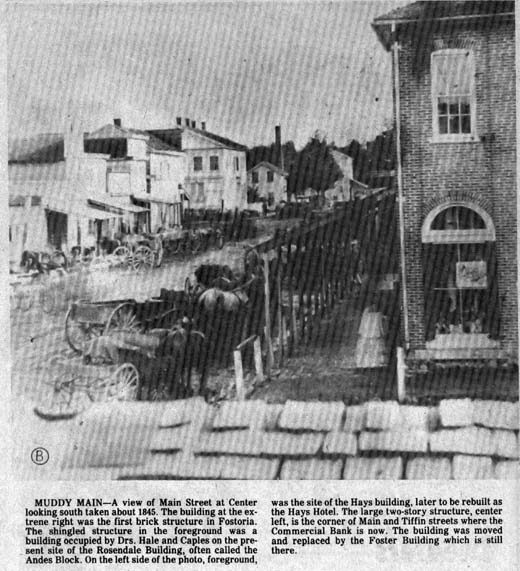September 21, 1978

Picture #1 – MUDDY MAIN – A view of Main Street at Center looking South taken about 1845. The building at the extreme right was the first brick structure in Fostoria. The shingled structure in the foreground was a building occupied by Drs. Hales and Caples on the present site of the Rosendale Building, often called the Andes Block. On the left side of the photo, foreground, was the site of the Hays building, later to be rebuilt as the Hays Hotel. The large two-story structure, center left, is the corner of Main and Tiffin streets where the Commercial Bank is now. The building was moved and replaced by the Foster Building which is still there.
Picture #2 (missing) – Charles “Gene” Wilson
Picture #3 (missing) – Paving brick from a Fostoria street weighing pounds.
Not many living Fostorians remember the days of mud streets in our town. The accompanying photo provides evidence they were here.
When I was a boy I remember some of the streets that were still unpaved then. When my family lived at corner of McDougal and Cadwallader, the street became a small river during a hard rain, and it didn’t drain away very fast. So, the neighborhood kids always had a big time wading knee-deep in the muddy water. It was still fun.
EARLY IMPROVEMENTS
The first drainage for our town was by open ditches, and the first one was from the southeast corner of Fremont and Perry streets, thence west along Fremont Street to Portage Creek. That first segment was completed in October 1856…and the cost was the amazing amount of $68.36, according to early records.
First improvement to Main Street was authorized by city council in 1859. Fifty car loads of stone were used on Main Street between Perry and Tiffin Streets. The stone cost $4.00 per load.
In 1870, city council created a board of improvement and employed a city engineer…James Lewis, appointed by Mayor Bricker. soon after that the first underground sewer (no.1) was authorized. It was a main sewer that began at Potter and Sandusky streets, thence across Perry Street and on west to College Ave., then north on Countyline to Fremont and west to Portage Creek.
LITTLE DONE BY 1880
During the 1880’s there were not any hardtop streets yet. After a hard rain it was almost impossible for a horse-drawn vehicle to traverse them. During the dry season it was conversely nearly as bad because of the dust created by the horse-drawn vehicles.
On Main Street, prior to paving, the dust was layed by a large tank-type sprinkling wagon, which applied water daily for a cost of $1.00 per month for each business establishment. Then in later years, when I was a boy, and the street was improved, Tom Duffey still sprinkled Main Street to lay the dust.
Gradually, sewers were extended and Fostoria’s streets were improved by one or more methods…some being cement, others macadam, and a few wood blocks saturated with preservative, but mostly were brick.
Today, Fostoria has 85 miles of hardtop streets. Those that were paved with bricks formed the substantial base for the successive layers of asphalt that have been applied in later years.
CHAMPION BRICK LAYER
Most Fostorians are unaware that a great contribution to the improvement of Fostoria’s streets was made years ago by Charles “Gene” Wilson, who earned the title of champion street brick later for this area…perhaps nationwide. He was written up in “Believe it or Not”, many years ago.
“Gene” as he was generally referred to, was credited with laying an average of 225 tons of paving bricks per day…and they were much heavier than normal construction bricks. Each one of those bricks measured 3 1/2 X 4 X 8 1/2 and weighed 10 pounds. One of the bricks shown in accompanying photo.
It took a crew of men just to keep Wilson supplied with the bricks as he worked with both hands picking them up and laying them in a checkerboard pattern. As a boy, I remember seeing him work…no lost motions…and oh how they went down. And oh how the perspiration poured off him.
SET RECORD
Wilson once set a record of laying 132 of the bricks in 55 seconds, which bettered his average record of 225 tons per day by a large margin.
Fostorian W.J. Banks recalls that “Gene” reportedly layed the bricks on Sandusky Street from Main, east to the railroad tracks in one afternoon. That’s a lot of 10 pound bricks to handle.
In later years, when there was no more street paving to be done, “Gene” worked on the county highways. Dan McGinnis, director at Kaubisch Memorial Library, remembers working with him at that time.
Wilson passed away in 1961, at age 76. His widow has remarried since his death and still lives in Fostoria, her name now being Mrs. Stanley Scales. Hubert Landers, a stepson resides in Columbus, Ohio.